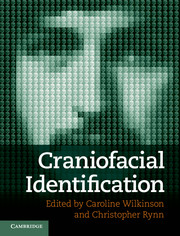Book contents
- Frontmatter
- Contents
- Contributors
- Part I Identification of the Living
- Chapter 1 Familiar face recognition
- Chapter 2 Unfamiliar face recognition
- Chapter 3 EFIT-V
- Chapter 4 Facial recall and computer composites
- Chapter 5 Facial ageing
- Chapter 6 Age progression and regression
- Chapter 7 Computer-assisted age progression
- Chapter 8 Facial recognition from identification parades
- Chapter 9 Virtual human identification line-ups
- Chapter 10 Computer-generated face models
- Chapter 11 Recognising and learning faces in motion
- Chapter 12 Facial image comparison
- Chapter 13 Three-dimensional facial imaging
- Part II Identification of the Dead
- Index
- Plate Section
- References
Chapter 12 - Facial image comparison
Published online by Cambridge University Press: 05 May 2012
- Frontmatter
- Contents
- Contributors
- Part I Identification of the Living
- Chapter 1 Familiar face recognition
- Chapter 2 Unfamiliar face recognition
- Chapter 3 EFIT-V
- Chapter 4 Facial recall and computer composites
- Chapter 5 Facial ageing
- Chapter 6 Age progression and regression
- Chapter 7 Computer-assisted age progression
- Chapter 8 Facial recognition from identification parades
- Chapter 9 Virtual human identification line-ups
- Chapter 10 Computer-generated face models
- Chapter 11 Recognising and learning faces in motion
- Chapter 12 Facial image comparison
- Chapter 13 Three-dimensional facial imaging
- Part II Identification of the Dead
- Index
- Plate Section
- References
Summary
Introduction
In this chapter, the problems associated with the individualisation of people depicted in photographic forensic evidence such as closed circuit television (CCTV) images are described. Evidence of this type may be presented in court and, even with high-quality images, human identification of unfamiliar faces has been shown to be unreliable. Therefore, facial image comparison or mapping techniques have been developed. These have been used by expert witnesses providing opinion testimony as to whether two images depict the same person or not. With photographic video superimposition, one image is superimposed over a second so that a series of visual tests can detect differences or similarities in facial features. With morphological comparison analysis facial features are classified into discrete categories, providing an indication of whether these are similar across images. Finally, with photo-anthropometry the proportional distances and sometimes the angles between facial landmarks are calculated and compared. Recent research using each technique is described, and the difficulties associated with their application in forensic settings evaluated. At present, no method provides certainty of identification and great care should be taken if presented in court to obtain a conviction without substantiating alternative evidence.
Government and private sector investment in crime prevention initiatives has made CCTV systems common in many urban areas. Although there are no official records, the UK probably has the highest density in the world, with at least 3 million cameras nationwide (McCahill and Norris, 2003; Norris et al., 2004). There may be as many as 26 million cameras in the USA (Washington Post, 8 October 2005) and large-scale implementation seems inevitable elsewhere (Norris et al., 2004). Widespread deployment of CCTV raises many issues. Concerns have been raised about infringement of rights to privacy (Norris and Armstrong, 1999; Introna and Wood, 2004) and crime prevention efficacy (Brown, 1995; Gill et al., 2005). In this chapter, we focus on the reliability of CCTV for identification purposes.
- Type
- Chapter
- Information
- Craniofacial Identification , pp. 136 - 153Publisher: Cambridge University PressPrint publication year: 2012
References
- 7
- Cited by



